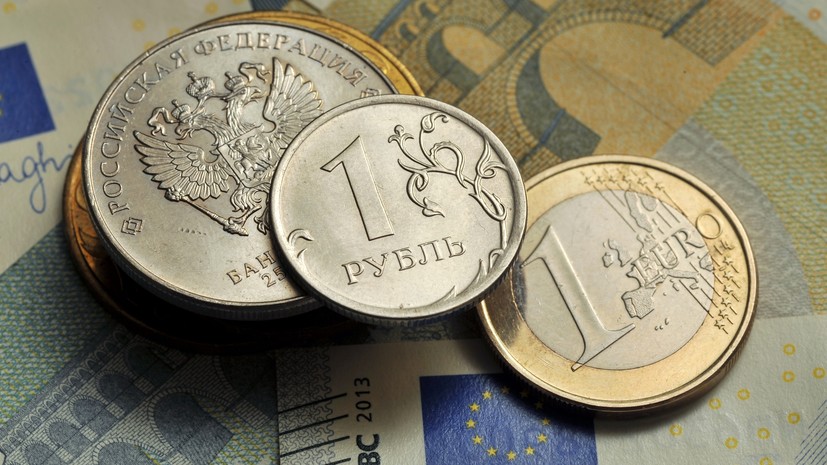On Thursday, May 11, the Russian currency shows mixed dynamics on the Moscow Exchange. In the middle of trading, the euro fell by 1.67% and for the first time since April 3 reached 82.16 rubles. At the same time, the value of the dollar fell by 1.08%, to 75.23 rubles, and the yuan - by 1.32%, to 10.81 rubles. The last time similar values could be observed was in the first half of March.
However, in the late afternoon, the euro, dollar and yuan rates moved to growth and at the moment rose above 84, 77 and 11 rubles, respectively. As Mikhail Zeltser, an expert on the stock market at BCS World of Investments, explained to RT, there was a "technical rebound" in the market in the afternoon. At the same time, the specialist does not expect the rates to return to the April highs.
Recall that in April, the value of the European, American and Chinese currencies on the Moscow Exchange at some point rose to 95.8, 83.5 and 12.1 rubles, respectively - the highest levels over the past year. After that, the values began to decline systematically, as the demand for rubles from business increased significantly. This was told to RT by the director of the analytical department of IC "Veles Capital" Ivan Manaenko.
According to him, Russian companies are now actively selling foreign exchange earnings and buying rubles for the upcoming payment of dividends. In addition, many organizations have already agreed with the government on voluntary one-time payments to the budget, for which the business also needs a large number of rubles, the expert said.
In addition, as the expert noted, recently in the West, statements about plans to strengthen control over the implementation of anti-Russian sanctions have been increasingly heard. Under these conditions, many companies prefer to further secure their own funds and convert existing euros and dollars into rubles.
"The rhetoric of the Central Bank also played a role in strengthening the ruble. Recently, the regulator reassured market participants who feared that foreign companies that had closed their business in Russia would withdraw large amounts of money from the country. Now, foreign organizations will have to coordinate such transactions with the Central Bank," Manaenko added.
- RIA Novosti
- © Evgeny Biyatov
Also, the ruble could be supported by changes in Russia's foreign trade, analysts are sure. In the previous few months, the currency received from exports entered the country in smaller volumes, while the interest of importers in foreign banknotes, on the contrary, increased, as the import of foreign goods increased. As a result, the demand for dollars, euros and yuan in Russia turned out to be greater than their supply, which led to a sharp depreciation of the ruble in April. However, today there has been a reverse trend in the market.
"The ruble is quickly catching up. The export bottom has already been passed, and the time lag for paying for winter supplies could reach three months, so right now we see the rapid recovery of the ruble. The imbalance between the supply of foreign currencies and the demand for them is going away - and quickly, "said Mikhail Zeltser.
However, according to the analyst, a certain pressure on the ruble is still exerted by a difficult situation with public finances. According to preliminary estimates of the Ministry of Finance of the Russian Federation, from January to April 2023, the federal budget of Russia was executed with a deficit of 3.42 trillion rubles. State treasury revenues decreased by 22% compared to the same period in 2022 and amounted to about 7.78 trillion rubles. At the same time, expenses increased by 26% to 11.2 trillion rubles.
On a monthly basis, the growth of government spending began to slow down after some expenditure items were rapidly financed at the beginning of the year. In turn, the non-oil and gas revenues of the treasury have already returned to growth, and oil and gas "are gradually entering a stable trajectory," the ministry said.
"The budget deficit is still high. However, judging by the dynamics of the balance sheet and taking into account the new tax policy, the failure of April revenues can be compensated already in the statistics of May. At the same time, advance expenses have already been carried out, which means that budget spending may slow down in the future. The normalization of the federal balance is not far off, and this is a promising factor in the strengthening of the ruble, "Zeltser suggested.
Nevertheless, even in the context of the budget deficit, investors still positively assess a number of macroeconomic indicators of Russia, which has a positive effect on the ruble, Ivan Manaenko believes. Thus, according to the Central Bank and Rosstat, inflation in the country for the first time in two years fell to 2.5%, and the unemployment rate remains historically low - 3.5%. At the same time, GDP by the end of 2023 may return to the growth trajectory after last year's recession and add about 0.5-2%.
Under these conditions, in the absence of new geopolitical upheavals, BCS World of Investments experts predict that the euro exchange rate will remain in the range of 81-83 rubles in the coming months, the dollar exchange rate in the corridor of 74-76 rubles, and the yuan exchange rate in the range of 10.5-11 rubles. A similar assessment is shared by Ivan Manaenko. In his opinion, the value of the US currency can stabilize near 75 rubles, and the Chinese - about 10.28-10.5 rubles.

